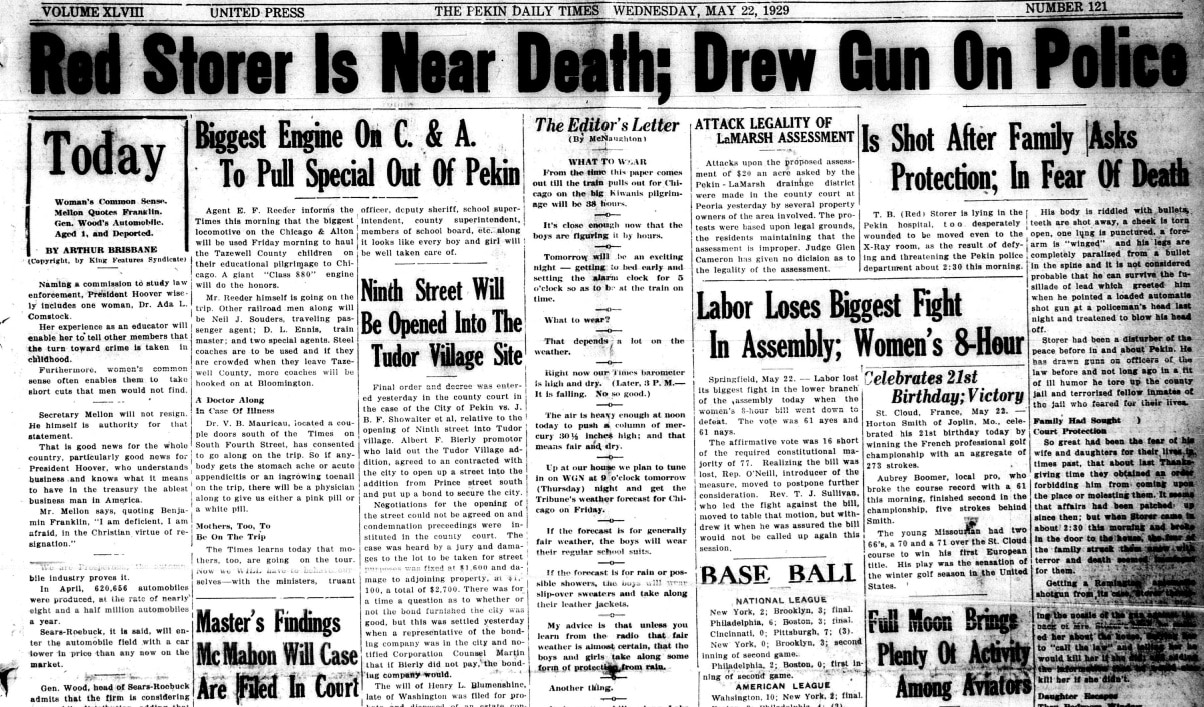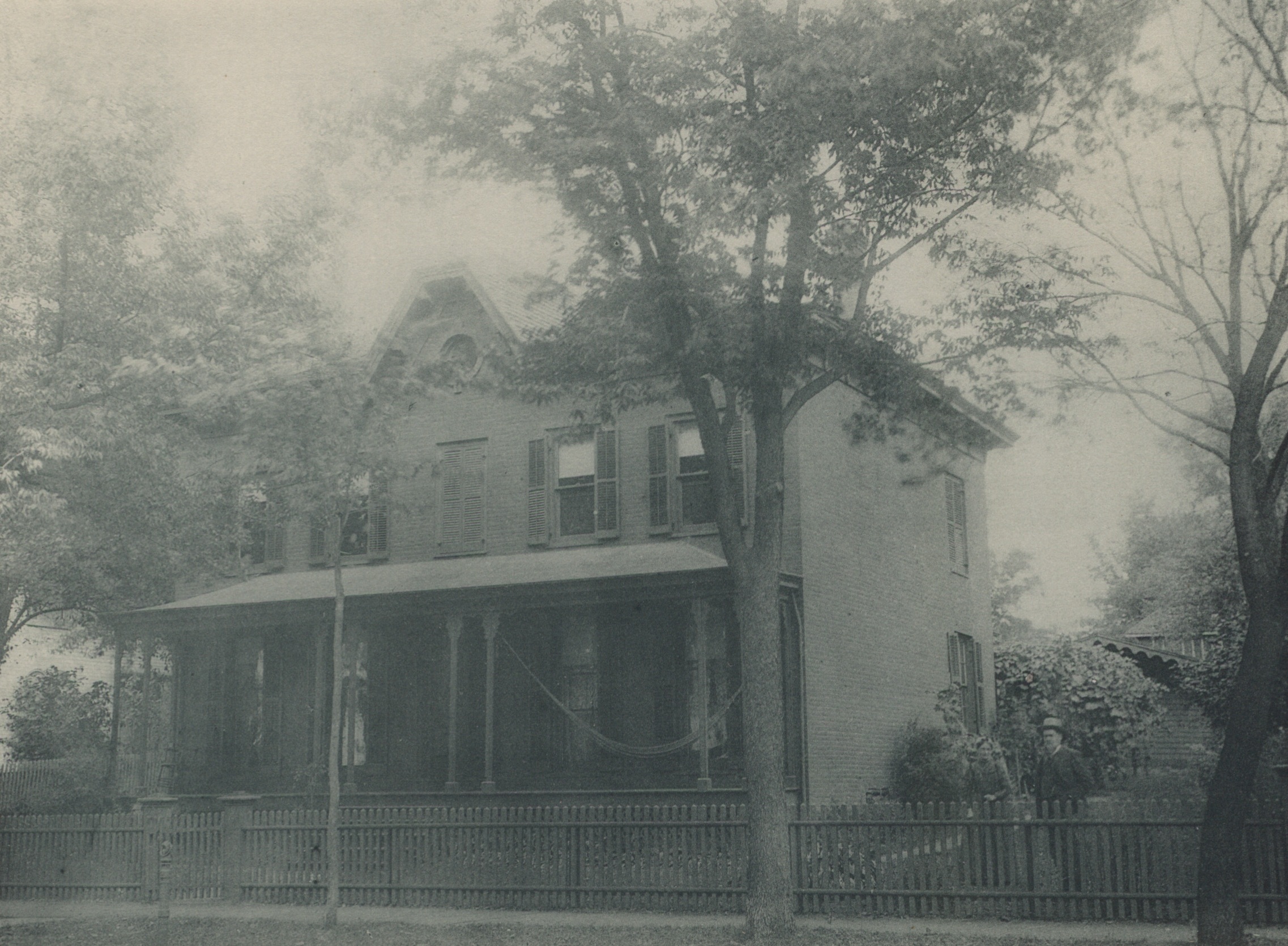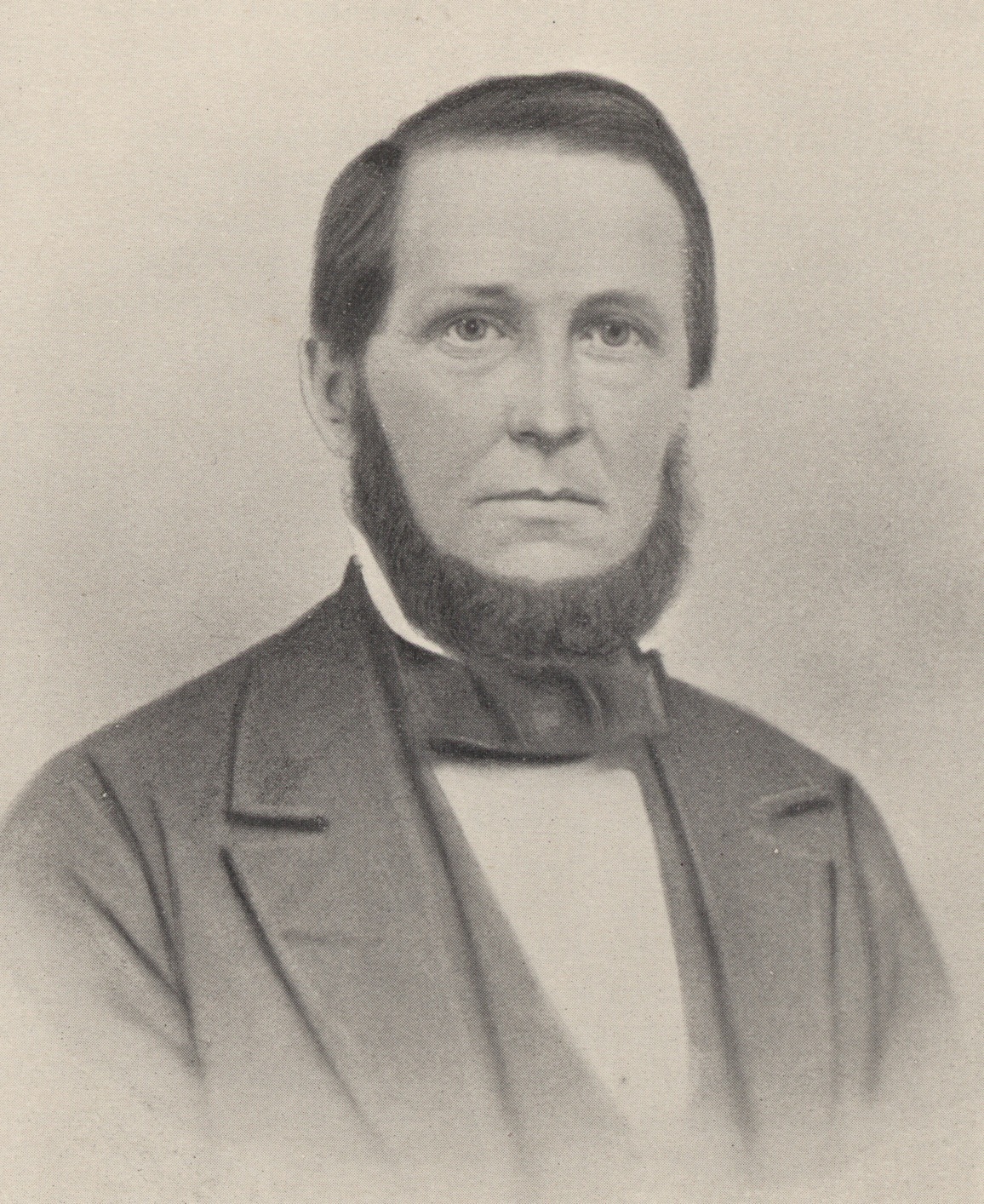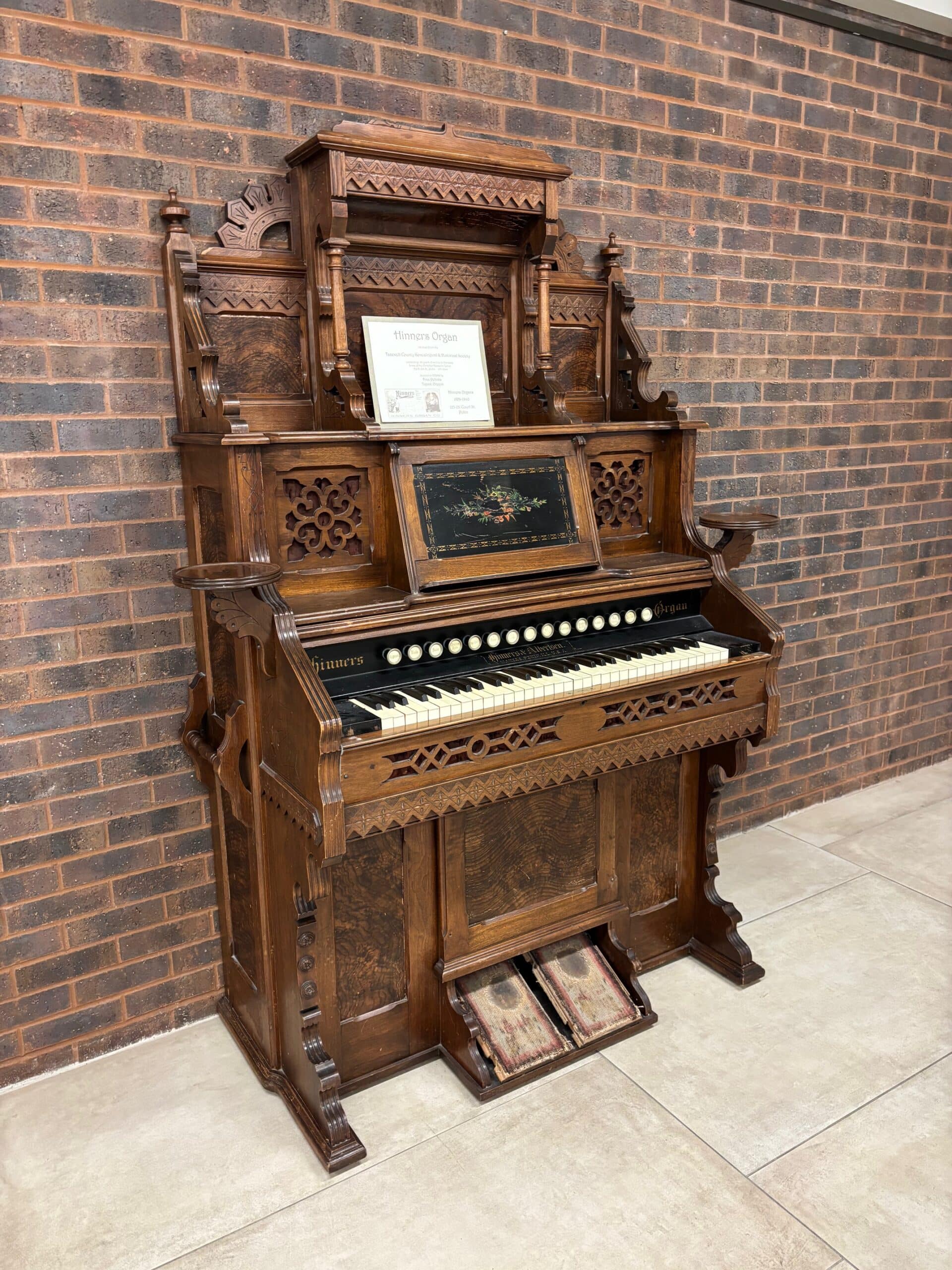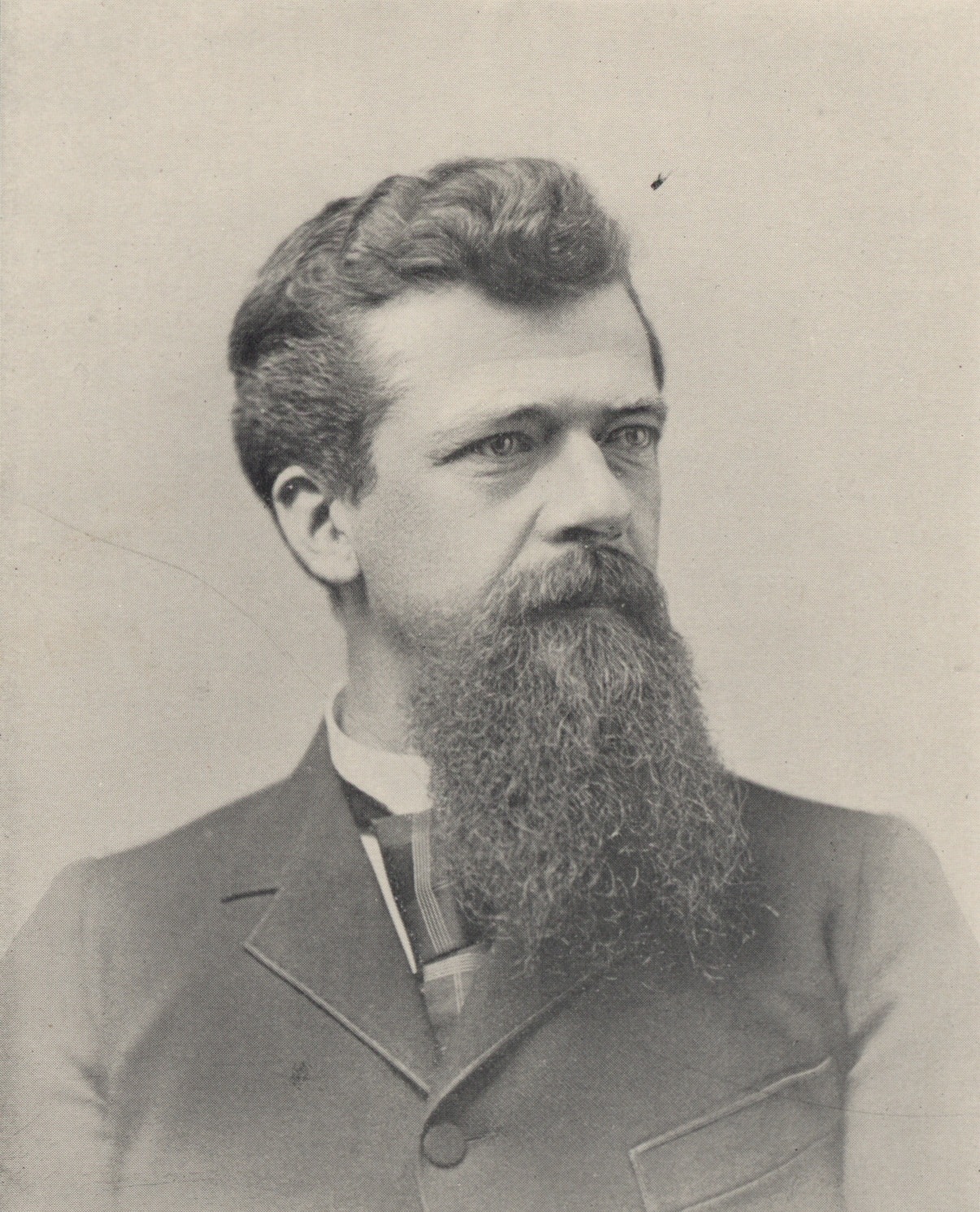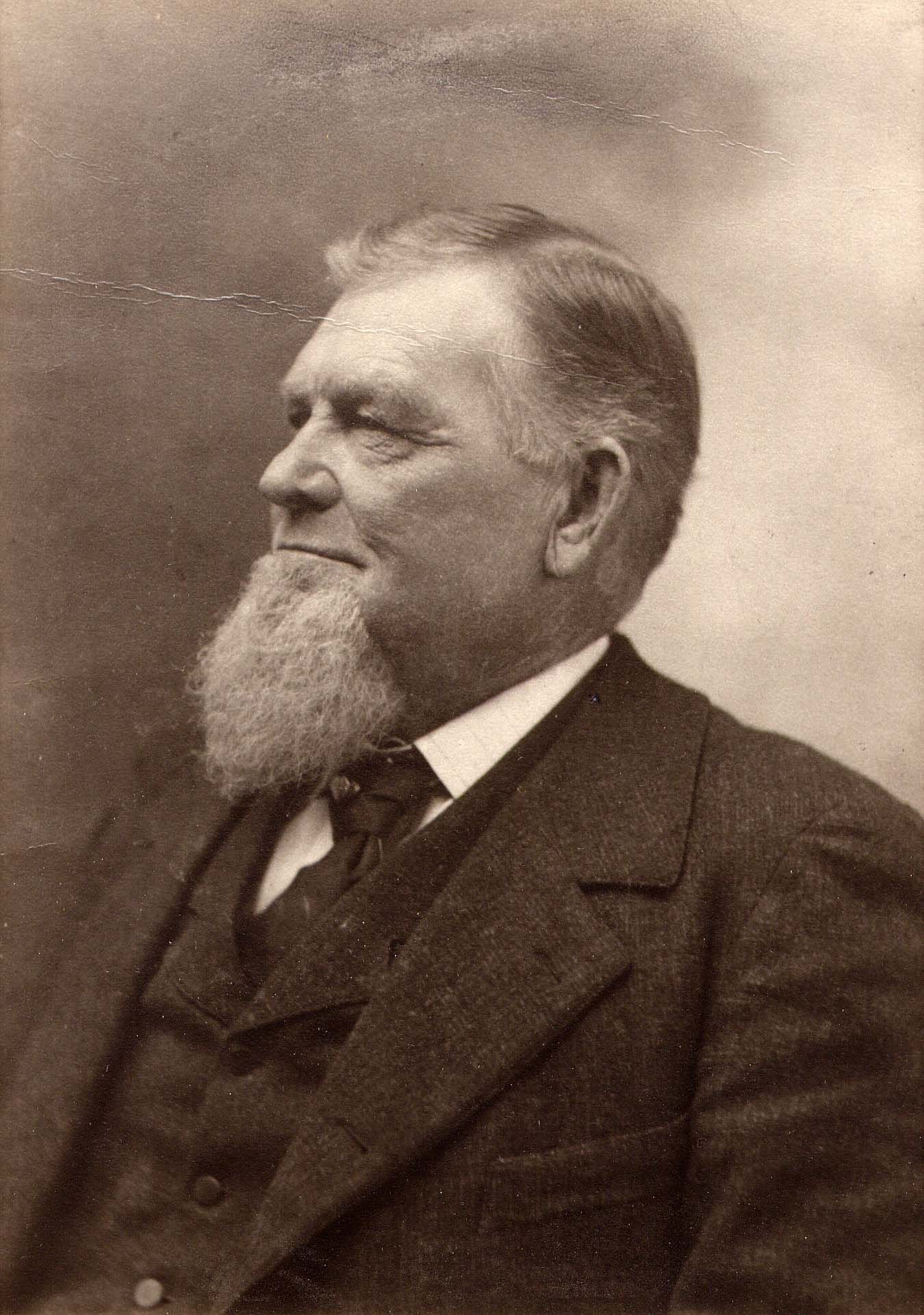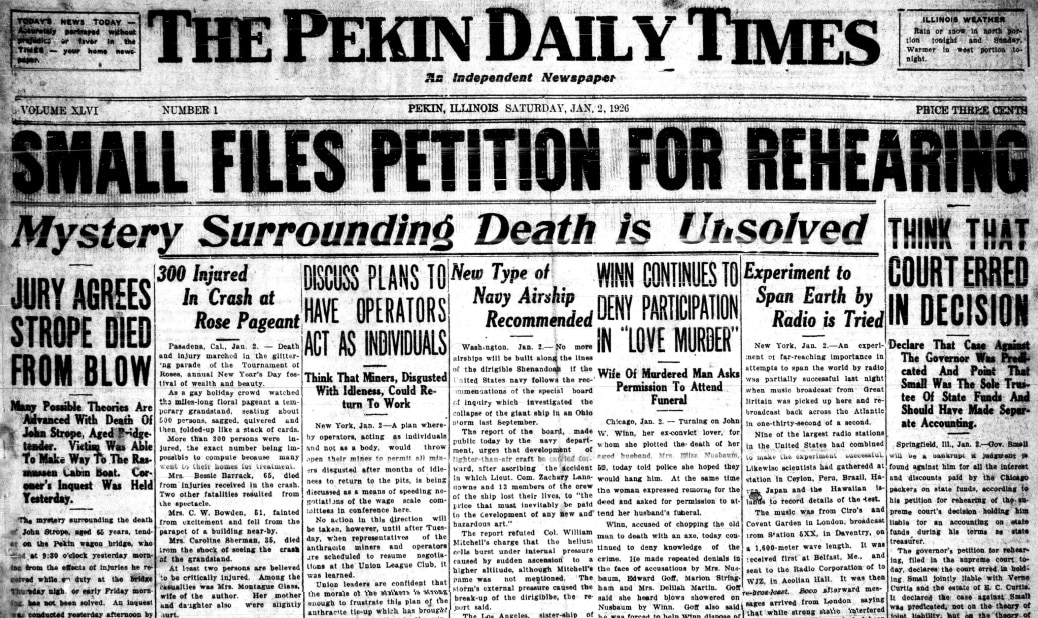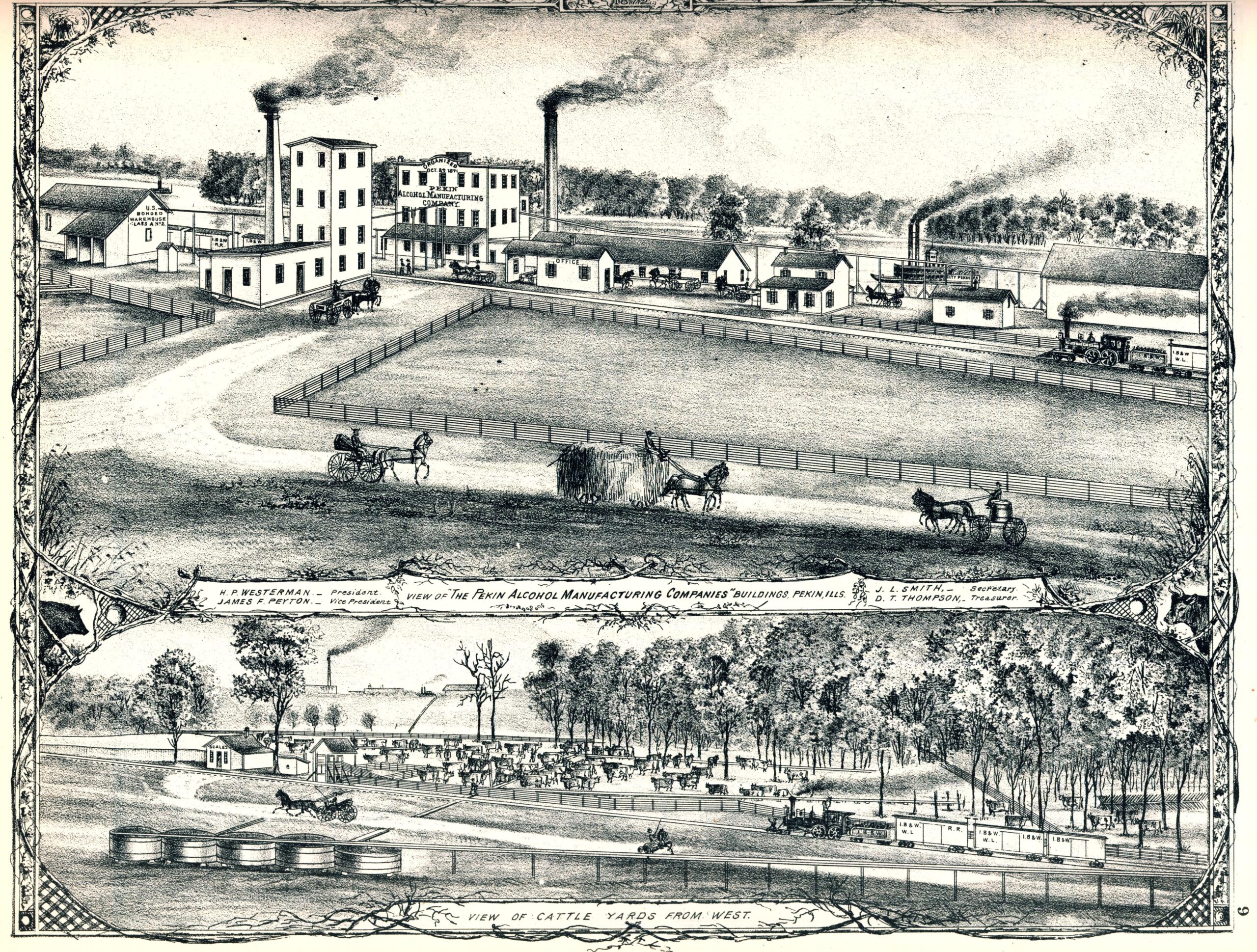Part One of our history of 1119 Hamilton Street reached as far as 1916, when the family of Don and Junie Marrs lived in that house. There is a gap in the record during these years, because the next Pekin city directory was not published until 1921 — but by that year the Marrs family had moved and a new family, the Storers, had taken up residence at 1119 Hamilton.
Thomas Bidwell “Red” Storer (1892-1929) and his wife Grace Frances (Mann) Storer (1894-1982) came to Pekin from Chicago in 1916. Before living in Chicago, Thomas and Grace had married in Joliet on 26 Aug. 1913. He was born in Lincoln, while Grace was born in Augusta in Hancock County, Illinois. It was in Chicago that their first child, Grace Annette, was born on 1 Aug. 1915. She was about a year old or less when her parents moved to Pekin, where Annette’s younger sister, Dorothy Mae, was born on 22 Sept. 1918. The 1916 city directory says the Storers first lived in Pekin at 1307 Charlotte St., but the 1920 U.S. Census shows them next door at 1309 Charlotte St. Both addresses are in the northeast corner of Bean Town.
Not long after the 1920 census, the Storers moved to 1119 Hamilton St., one block north and two blocks west of 1307 Charlotte. It is at 1119 Hamilton that they are listed in the 1921 Pekin city directory. Thomas and Grace are shown at that address in all the Pekin directories during the 1920s — 1921, 1922, 1924, 1926, and 1928. The directories of 1916, 1921, and 1926, as well as the 1920 U.S. Census, show his occupation as “electrician,” with the 1920 census adding that he worked as an electrician in a yeast factory (probably Liberty Year Corporation on Second Street).
Besides those years when he worked as an electrician, Thomas is listed as a trucker in 1922 and again in 1928, but in 1924 he had a “soft drinks” business at 306 Margaret St. The frequent change of jobs is a telltale sign of trouble in the Storer home, for the instability in Thomas’ character that it suggests resulted from his very serious drinking problem. During the Prohibition Era of the Roaring Twenties, a man who was prone to drinking to excess would inevitably — and in no time — come to be on a first-name basis with local law enforcement. That was even more the case when the heavy drinker was someone who hated the police and loved firearms, and who was prone to become very violent when drunk. In truth, it is more than likely that Thomas’ “soft drinks” business at 306 Margaret St. was a front for a speakeasy selling bootleg liquor, and his work as a trucker no doubt provided him the opportunity to smuggle bootleg liquor in Central Illinois.
Consequently, it was not long before almost every officer in the Pekin Police Department had had personal, and unpleasant, dealings with “Red” Storer. Nearby police departments also had to respond to Red’s misconduct.
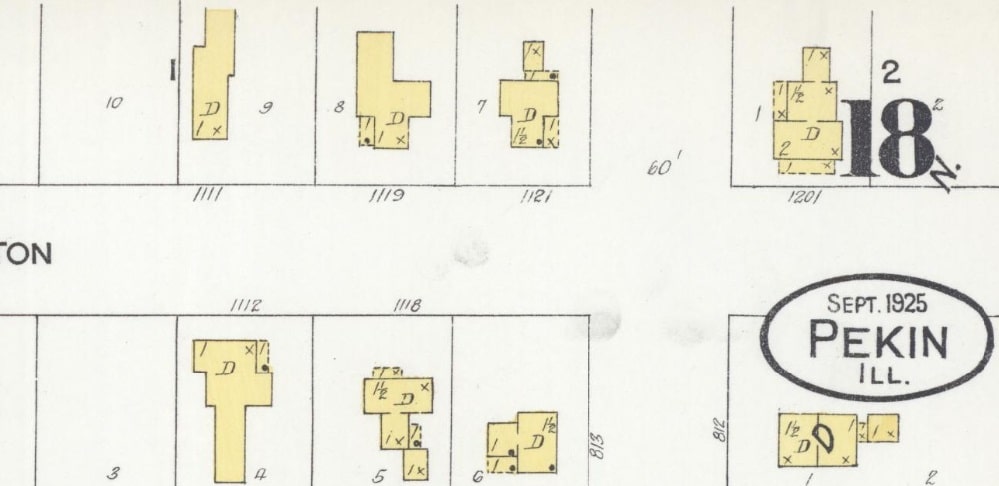
Red’s heavy drinking and violent nature were a very sore trial for his wife Grace and their two little girls. Grace suffered violence and threats at her husband’s hands, and Annette and Dorothy lived in terror of his rages. In one incident, Red drew his gun on Pekin officers Roney Bruder and Frank Ehrett, who had responded to yet another report of disturbance of the peace at the Storer home. That time, Red ordered Bruder and Ehrett off his property, saying they had no business there without a warrant. Another time, while Red was held at the Tazewell County Jail, he overturned and wrecked jail cell furnishings and fixtures, his rages putting his fellow jail inmates in fear for their lives.
Matters reached extremes around Thanksgiving time in 1928, when Red held a shotgun to Grace’s head and threatened her life. In the same incident, Red drew a gun on Pekin Police Chief Earl Whitmore. Thankfully, on that occasion Red surrendered, and Officer Jack DeFrates took three guns off his person. Immediately afterward, Grace took out an order of protection against Red — but within a few months, Red was again living at home.
Sadly, as often happens in these terrible situations, matters came to a head in the early morning hours of Wednesday, 22 May 1929, as we see from that day’s Pekin Daily Times front page headline story:
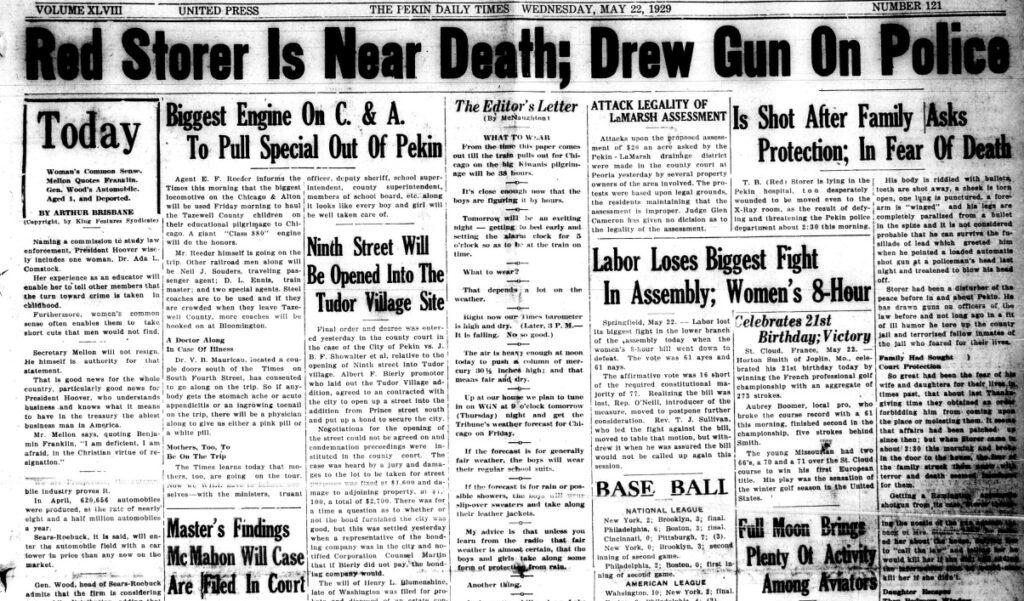
Note that Red Storer had become so notorious in Pekin and the surrounding area that the Daily Times seems to have assumed that their readers already knew who he was. Following is a nearly complete transcription of that headline story. However, I have omitted a needlessly, indeed shockingly, graphic description of Storer’s gunshot wounds.
Red Storer Is Near Death; Drew Gun On Police
Is Shot After Family Asks Protection; In Fear Of Death
T. B. (Red) Storer is lying in the Pekin hospital, too desperately wounded to be moved even to the X-Ray room, as the result of defying and threatening the Pekin police department about 2:30 this morning.
. . . it is not considered probable that he can survive the fusillade of lead which greeted him when he pointed a loaded automatic shot gun at a policeman’s head and threatened to blow his head off.
Storer has been a disturber of the peace before in and about Pekin. He has drawn guns on officers of the law before and not long ago in a fit of ill humor he tore up the county jail and terrorized fellow inmates of the jail who feared for their lives.
Family Had Sought Court Protection
So great had been the fear of his wife and daughters for their lives in times past, that about last Thanksgiving time they obtained an order forbidding him from coming upon the place or molesting them. It seems that affairs had been patched up since then; but when Storer came in about 2:30 this morning and broke in the door of the house, the fear of the family struck them anew with terror and death seemed imminent for them.
Getting a Remington automatic shotgun from its case, Storer threatened wildly what he would do. Placing the nozzle of the gun against the back of Mrs. Storer’s head, he walked her about the house, defying her to “call the law” and telling her he would kill her if she did, and adding the information that he would also kill her if she didn’t.
Daughter Escapes Thru Bedroom Window
At this stage Annette or [sic – and] Dorothy, the daughters, escaped through a bedroom window at the east of the house and ran across Twelfth Street to the Jacob Meyer home at the corner of Twelfth and Hamilton. (The Storer home is at 1119 Hamilton). Calling Assistant Chief Harm Smith, the terrified daughter asked him to send police at once to the home. It was necessary to flash the signals to round up the night policemen and before they could be assembled and get into the police car a second and third call came urging the police to come quick lest lives be lost.
The men knew they were going on a dangerous mission. The man they were going after had stuck a gun to the stomach of their chief, and they had heard that he had made threats against them. They did not know what Mrs. Storer later told police — that he made his threats that they would not take him alive and that he would “get two or three of them” before they would get him.
Had Parked Car To Floodlight Porch
Arriving at the Hamilton Street home, the police found an odd situation. Instead of driving his Chrysler in as he usually does, he had swung around through the lawn on the east side of the house and had stopped his car with the headlights pointing toward the street. Thus they flooded the back porch and approach to the house with light into which the policemen would have to walk. Whether Storer planned to make trouble and expected the police is a question in the minds of the officers. They had seen him go up Court Street “about sixty miles an hour” about 2 o’clock and had remarked to one another that they’d probably get a call in a short while.
“First Make Sure You Are Right”
The policemen had strict orders to make sure they were right before going ahead; but they understood that they were not required to stand up and be shot at a while before pulling their own triggers.
Their first investigation showed that trouble was being raised in the house. A table was upset and furniture was disturbed and there was evidence that the phone call resulted from actual fear of their lives on the part of the family.
Tried to Talk to Him First
Despite this, the officers decided to try to talk to Storer. Roney Bruder and Fred Ewing were stationed at the front of the house and Frank Mills and John DeFrates went to the rear door. There is a small screened in porch at the rear. It was through the door from the rear porch to the house that Storer had broken in when he came home.
Mills stepped up to the screen door and knocked. Mills did not draw his gun. He left it in his holster and waited with empty hands for Storer to come up.
This Storer did promptly with an automatic shotgun in his hands and pointing it at Mills he threatened to kill him forthwith. DeFrates, who was with Mills, saw that his buddy’s life was in imminent danger and he fired at once.
Empties His .38 Smith Wesson Special
DeFrates did not have an automatic. He carried a short Smith & Wesson .38 special. It is necessary to pull the trigger each time to fire it. DeFrates fired all six shots as Storer jumped through the screen, ducked and dodged around the corner in an effort to get behind cover where he could shoot down the officers who were in the glare of the Chrysler’s headlamps.
Mills, who had jumped into a latticework and injured his hand to avoid looking straight down the barrel of the shotgun while he got his gun from his holster, and DeFrates, who now had an empty gun, both got into the shadows. They expected that Storer would come around the house and get them from behind, shooting from the shadow at them in the light.
DeFrates Goes Around to Meet Him
Realizing they were either going to have to run in disgrace or meet Storer before he got them in the light, DeFrates, who is quick as a cat, grabbed a second gun and circled around the south side of the house to meet Storer on the East Side. There DeFrates found Storer with gun pointed and ready for instant firing. But DeFrates was quicker on the trigger and Storer crumpled.
It was a harrowing experience and any one or all four of the policemen might have been dead today for Storer’s gun when emptied at the police station this morning, was found to have a shell in it for each officer; and one was in the barrel ready for instant service.
His face bleeding, his arm helpless, and his legs paralyzed, Storer was loaded into his own car and taken to the hospital where Dr. Balcke was called to care for him. Whether he can survive the riddling which his body received is a question.
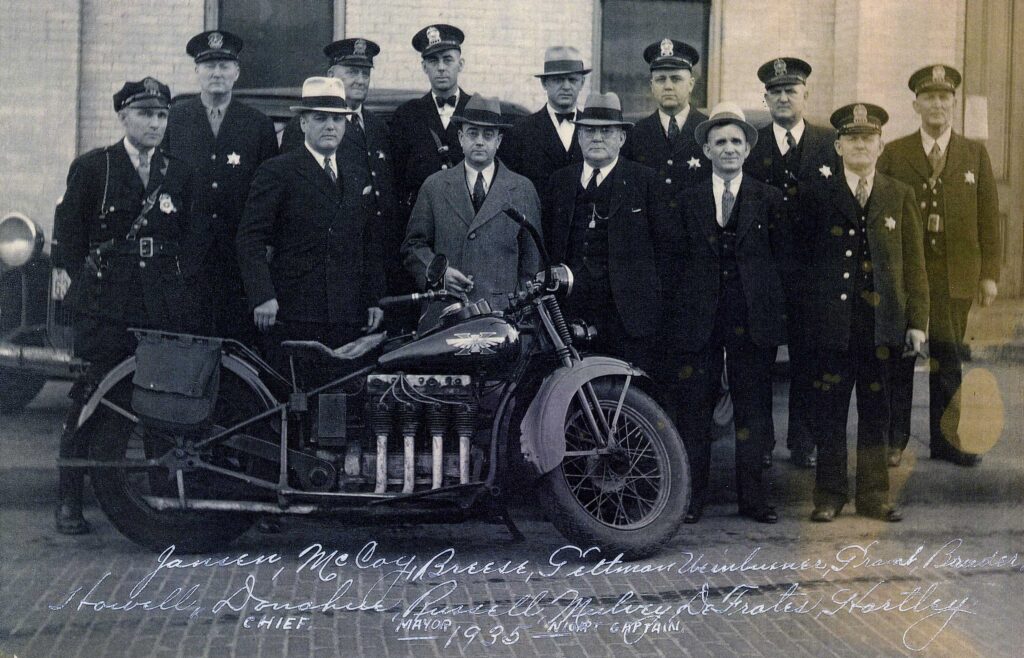
As expected, Storer did not survive his wounds, dying at Pekin Public Hospital less than 22 hours after he was shot. Here is the front page story about his death from the Thursday, 23 May 1928 edition of the Pekin Daily Times:
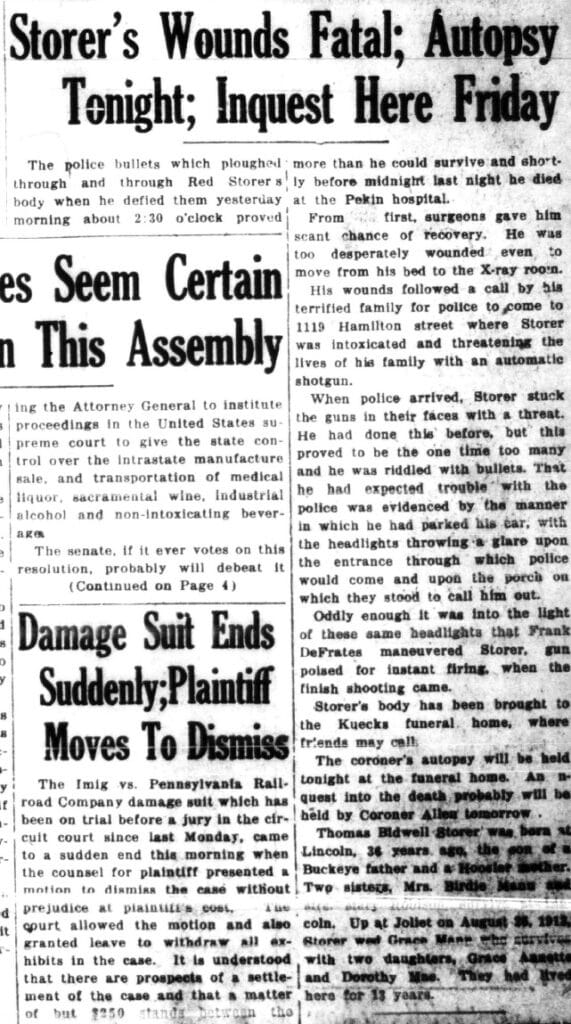
Here is a complete transcription of the above news report:
Storer’s Wound Fatal; Autopsy Tonight; Inquest Here Friday
The police bullets which ploughed through and through Red Storer’s body when he defied them yesterday morning about 2:30 o’clock proved more than he could survive and shortly before midnight last night he died at the Pekin hospital.
From the first, surgeons gave him scant chance of recovery. He was too desperately wounded even to move from his bed to the X-ray room.
His wounds followed a call by his terrified family for police to come to 1119 Hamilton street where Storer was intoxicated and threatening the lives of his family with an automatic shotgun.
When police arrived, Storer stuck the guns (sic) in their faces with a threat. He had done this before, but this proved to be the one time too many and he was riddled with bullets. That he had expected trouble with the police was evidenced by the manner in which he had parked his car, with the headlights throwing a glare upon the entrance through which police would come and upon the porch on which they stood to call him out.
Oddly enough it was into the light of these same headlights that Frank DeFrates (sic – John DeFrates) maneuvered Storer, gun poised for instant firing, when the finish shooting came.
Storer’s body has been brought to the Kuecks funeral home, where friends may call.
The coroner’s autopsy will be held tonight at the funeral home. An inquest into the death probably will be held by Coroner Allen tomorrow.
Thomas Bidwell Storer was born at Lincoln, 36 years of ago, the son of a Buckeye father and a Hoosier mother. Two sisters, Mrs. Birdie Mann and Mrs. Mary Robison, survive in Lincoln. Up at Joliet on August 26, 1913, Storer wed Grace Mann who survives with two daughters, Grace Annette and Dorothy Mae. They had lived here for 13 years.
The next day, 24 May 1929, the Pekin Daily Times published its report on the inquest into Red Storer’s death that was held that morning by Tazewell County Coroner Arthur E. Allen at Kuecks Funeral Home (which was located at the current site of the Pekin Municipal Building and Pekin Police Department). Officer DeFrates was found to have acted in self-defense, and he and his three fellow officers were ruled to have been acting in the line of duty.
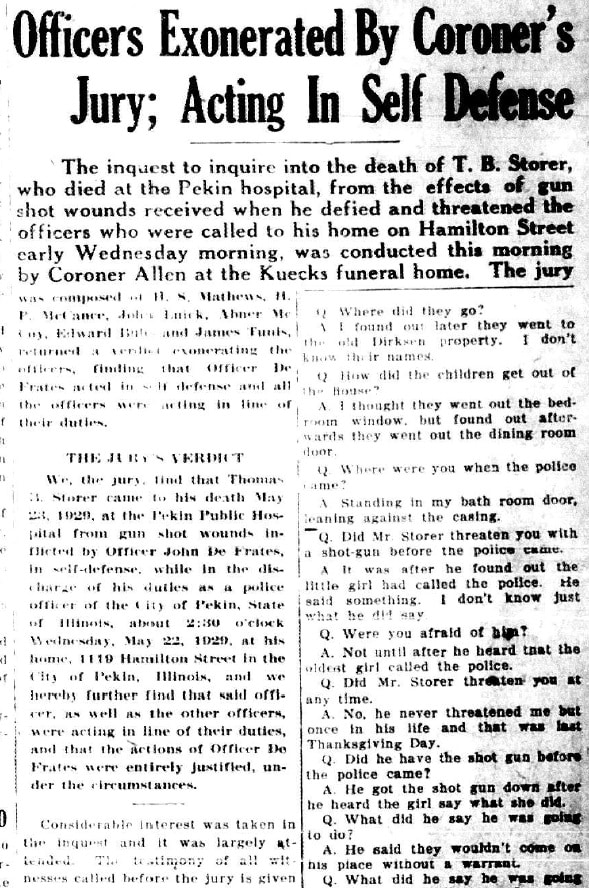
Following is a transcription of the first three paragraphs of the Pekin Daily Times’ report on the Storer inquest:
Officers Exonerated By Coroner’s Jury; Acting In Self Defense
The inquest to inquire into the death of T. B. Storer, who died at the Pekin hospital, from the effects of gun shot wounds received when he defied and threatened the officers who were called to his home on Hamilton Street early Wednesday morning, was conducted this morning by Coroner Allen at the Kuecks funeral home. The jury was composed of H. S. Mathews, H. P. McCance, John Luick, Abner McCoy, Edward Buhs, and James Tunis, returned a verdict exonerating the officers, finding that Officer DeFrates acted in self-defense and all the officers were acting in line of their duties.
THE JURY’S VERDICT
We, the jury, find that Thomas B. Storer came to his death May 23 [sic – 22], 1929, at the Pekin Public Hospital from gun shot wounds inflicted by Officer John DeFrates, in self-defense, while in the discharge of his duties as a police officer of the City of Pekin, State of Illinois, about 2:30 o’clock Wednesday, May 22, 1929, at his home, 1119 Hamilton Street in the City of Pekin, Illinois, and we hereby further find that said officer, as well as the other officers, were acting in the line of their duties, and that the actions of Officer DeFrates were entirely justified, under the circumstances.
Considerable interest was taken in the inquest and it was largely attended. . . .
It should be noted that the Daily Times’ report on the inquest verdict conflicts with their previous reporting that said Storer had died shortly before midnight on the night of May 22. His death certificate and gravestone both say he died May 22, not May 23.
As was its usual practice with prominent crime stories back then, the Daily Times published the complete transcript of the testimony given at the inquest, with the testimony beginning on the front page, continuing on page 3, then jumping to page 7, and finally concluding with text that took up the greater part of page 8 of the newspaper. For the purposes of space, however, I will limit myself to highlights from the inquest testimony.
The witnesses who were called, in order, were: Mrs. Grace Storer, Police Chief Earl Whitmore, Mrs. Jacob Stockert, 1201 Hamilton St. (the Storer girls ran to her house, the former Dirksen home, three times during the incident), Officer Harm H. Smith, H. A. Ballenger, Officer Frank H. Mills, Mrs. Grace Storer (further testimony), Officer John DeFrates, Officer Roney Bruder, Officer Fred Ewing, and Officer Mills (recalled).
Officer Mills testified that of the four responding officers, it was decided that he should approach the house, since although he had arrested Red before, Red had never directed harsh words at him before.
Approaching the door, Mills announced, “It’s me, Red.” But Red replied, “I don’t give a damn who you are! Get out of my yard or I’ll blow your [expletive] head off!“
When Red went to the door to confront the police, Grace quickly took the opportunity to try to escape out a window, but Officer Bruder saw her and, aware of the danger if bullets would start to fly, he quickly told her to stay inside.
One of the more remarkable things that we see in Grace’s testimony is a tendency to deny or downplay the seriousness of her late husband’s conduct. At one point she even claimed that after DeFrates had shot Red, the police officers ignored his pleas for mercy and shot him repeatedly as he lay wounded on the ground. Nevertheless, inquest testimony reveals that as Storer lay gravely wounded in his yard and was about to be carried by the police to be taken to the hospital, Grace looked down at him and said, “I don’t feel sorry for you. You have been looking for this a long while.“
After arriving at the hospital, Storer vowed revenge against the police who were attending him. “If I get over this, it will be too bad for you [string of expletives]. I have to get over it, so I can get even with you.“
Following the inquest, that evening the Storer family had a visitation at their home, to which Red’s body had been taken after the autopsy. The next day, Saturday, 25 May 1929, the funeral was held at Kuecks Funeral Home, with the Rev. J. C. Brown officiating. Interment followed in Lakeside Cemetery.
In the aftermath of Red Storer’s death, his widow Grace and two daughters (who were 13 and 10 years of age, respectively, at the time of their father’s death) continued to live at 1119 Hamilton St. for a few years. The 1930 Pekin city directory lists her as “Storer Grace F. (wid Thos B) h1119 Hamilton.” However, in the 1932 city directory we find that Grace had moved to 1021 Charlotte St., and that Virgil Arthur (1899-1959) and his wife Irene were then living at 1119 Hamilton St. Arthur, a driver for the Charles F. Helmig Trucking Co., may have only been renting the house, though, because in the 1934 Pekin city directory we find that Grace’s older daughter Annette was at that time living at 1119 Hamilton with her husband Charles Donald “Don” Alexander (1914-1989), whom she had married in 1931. The directory entry indicates that Annette and Don had one child — that is, their eldest child Charles Ronald “Ron” Alexander (1933-2014). Annette and Don subsequently had a daughter, Barbara Jean (Alexander) Mann (1935-2015).
Annette and Don and their children continued to live at 1119 Hamilton until about 1940, as shown by the 1934, 1937, and 1939 Pekin city directories. Don worked as a station manager or attendant for the Deep Rock Oil Co., but by 1939 he had gone to work as a clerk in his father Ray’s grocery store in Normandale. Thus, 1939 is the last year that a member of the Storer family is listed at 1119 Hamilton St.
That same year, Annette’s younger sister Dorothy married Bruce L. Owen (1917-1984), with whom she had a daughter, Jan (Owen) Maas. Dorothy and her family lived at 1107 Hamilton St., just a few houses away from the former Storer home. Dorothy was a homemaker, a member of First Christian Church in Pekin, and a teen leader and board member of the YWCA of Pekin. Her older sister Annette, meanwhile, worked in the 1950s and 1960s as manager of the paint department at the former Carson Pirie Scott in Peoria, later working from 1971 to 1977 in the fine jewelry department at Bergner’s in the Pekin Mall.
Red Storer’s widow Grace, who was 35 when her husband was killed, never remarried. To support her family, she went to work at Cohen Furniture Store, being employed in the drapery and sale departments at both the Pekin and Peoria stores. She also became a buyer for the Clark & Company of Peoria, and also worked until her retirement as a house and resident director of the Peoria YWCA. She passed away at the age of 88 on Monday, 15 Nov. 1982, at Hopedale Medical Complex, where she had been a patient for the last seven months of her life. She was buried by her late husband’s side in Lakeside Cemetery. Her daughters and sons-in-law are also buried in Lakeside.
The memory of Red Storer and his death under a hail of police bullets lingered on not only in the neighborhood of 1119 Hamilton St., but was even mentioned 20 years later in the 1949 Pekin Centenary volume, on page 61 — “May 22, 1929, Police Officer Jack DeFrates shot and killed T.B. ‘Red’ Storer at Storer’s home here in Pekin, . . .” Storer’s death was again mentioned in “Pekin: A Pictorial History” (1998, 2002), page 150 — “In May of 1929, Officer Jack DeFrates shot and killed T. B. Storer while attempting to arrest him.” (a less than accurate summary of the incident which ended with Storer’s death). Most recently, the 2024 Pekin Bicentennial Pictorial, page 102, again recalled Storer’s death in these words:
“That decade in Pekin police history concluded with the death of gun-wielding gangster T. B. ‘Red’ Storer on May 22, 1929, who was shot by Officer Jack DeFrates while Storer was terrorizing his family and threatening the police.“
In the conclusion of our series on the history of 1119 Hamilton St. next week, we will see that Red Storer’s crime spree and violent death is not the only tragedy that unfolded at this house.


